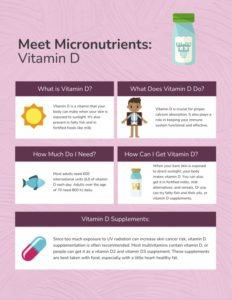Micronutrients: Vitamin D
Now that it's officially Spring, let's help your clients get outside with this spotlight on vitamin D!What Is It? Vitamin D is a vitamin that your body can make when your skin is exposed to sunlight. It's also naturally present in fatty fish and available in many fortified foods like milk. You can even get vitamin D supplements.What Does It Do? Vitamin D is crucial for proper calcium absorption. It also plays a role in keeping your immune system functional and effective. Plus, vitamin D comes in handy when your muscles need to move and your nervous system needs to send messages.How Much Do I Need? Most adults need 600 international units (IU) of vitamin D each day. Adults over the age of 70 need 800 IU daily.You can find more detailed information about vitamin D needs across the population in this handy chart!How Can I Get Enough Vitamin D? That answer is a little tricky. Historically, Americans aren't great at meeting their daily vitamin D needs. The 2015 Dietary Guidelines for Americans even said that "vitamin D [is] considered [a] dietary [component] of public health concern for the general U.S. population" (source).When your bare skin is exposed to direct sunlight, your body makes vitamin D. However, skin tone, sunscreen, age, and even the presence of clouds or smog can affect this connection. Plus, too much UV exposure can increase the risk of skin cancer.At the same time, vitamin D is rarely naturally present in most foods. Fatty fish -- as we mentioned above -- are the best sources, along with their oils. Eggs, cheese, and beef liver also have some vitamin D, but not much.So the answer seems to be supplementation and fortification. Most milks and milk alternatives are fortified with vitamin D, as are some breakfast cereals. Additionally, there are a wide range of supplements that people can take.Yet not all supplements are created equal. According to the National Institutes of Health's Office of Dietary Supplements, "The two forms of vitamin D in supplements are D2 (ergocalciferol) and D3 (cholecalciferol). Both forms increase vitamin D in your blood, but D3 might raise it higher and for longer than D2. Because vitamin D is fat-soluble, it is best absorbed when taken with a meal or snack that includes some fat."The National Institute of Arthritis and Musculoskeletal and Skin Diseases further chimes in with, "Calcium supplements are better absorbed when taken in small doses (500 mg or less) several times throughout the day. In many individuals, calcium supplements are better absorbed when taken with food."Whew! That was a lot about this amazing micronutrient. Here's a printable handout that you can download today: Meet Micronutrients: Vitamin D This is the sixth installment of our Vital Micronutrients series. Here are the others:
This is the sixth installment of our Vital Micronutrients series. Here are the others:
- What Are Micronutrients?
- Introduction to Micronutrients
- Micronutrients: Vitamin A
- Micronutrients: Folate
- Micronutrients: Iodine
And stay tuned for the next micronutrient on deck: iron!References:
- https://ods.od.nih.gov/factsheets/VitaminD-HealthProfessional/
- https://ods.od.nih.gov/factsheets/VitaminD-Consumer/
- https://www.hsph.harvard.edu/nutritionsource/vitamin-d/
- https://www.dietaryguidelines.gov/resources/2020-2025-dietary-guidelines-online-materials/food-sources-select-nutrients
- https://www.bones.nih.gov/health-info/bone/bone-health/nutrition/calcium-and-vitamin-d-important-every-age


